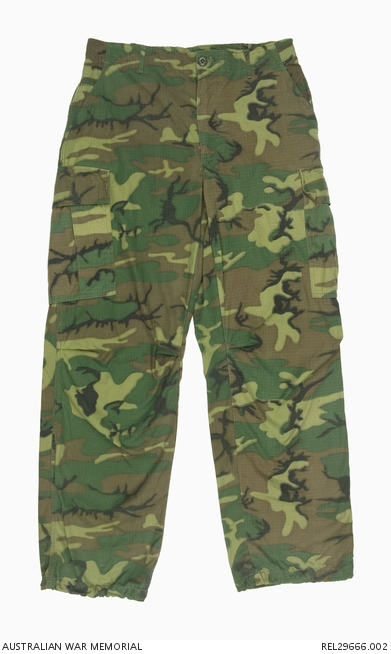| Place | Asia: Vietnam |
|---|---|
| Accession Number | REL29666.002 |
| Collection type | Heraldry |
| Object type | Uniform |
| Physical description | Cotton poplin, Nylon, Plastic |
| Location | Main Bld: Vietnam Gallery: Ramp: Operations |
| Maker |
Unknown |
| Place made | United States of America |
| Date made | c 1970 |
| Conflict |
Vietnam, 1962-1975 |
ERDL camouflage trousers : Trooper D R Barnby, 2 Squadron, Special Air Service Regiment

Pair of ERDL camouflaged Ripstop trousers, fitted with olive green plastic buttons. A pair of slash pockets are fitted at the hips. The trousers have a waist band with four belt loops and a concealed button fly closure. The trousers feature a concealed map pocket, with button opening on each thigh. The bottom of each trouser leg has an internal loop of fabric to blouse the trousers. The Ripstop material in the trousers includes nylon threads cross hatched through the cotton base fabric.
This distinctive camouflage is the ERDL pattern which was developed by the United States Army at the Engineer Research & Development Laboratories (ERDL) in 1948, and was first issued to US special operations units and the Australian Special Air Service Regiment (SASR) operating in South Vietnam from early 1967. This ERDL variation is also known as the brown based 'highland' or 'wet season' type.
Donald Richard Barnby was born in Brewarrina, NSW on 8 April 1950. After leaving school and taking on temporary jobs in the Wellington area of NSW, he joined the Australian Regular Army on 17 May 1967 and was allocated the service number, 217585. After completing basic training at Kapooka Barnby sought a combat role, but to his disappointment, was posted to the Royal Australian Ordnance Corps. He completed his Initial Employment Training at Army training facilities at Bonegilla and Bandiana in Victoria and was posted to 2 Base Ordnance at Moorebank, NSW.
A friend joined the SASR and convinced him to so too. In 1970, Barnby passed the gruelling cadre course for entry into the elite SASR, based out of Swanbourne Barracks in Perth, WA. Barnby qualified as a parachutist, and became part of the Free Fall Troop otherwise known as 'F Troop' of the SASR. At this time there was a popular American comedy series called 'F Troop', about American soldiers based at Fort Courage, a fictional army outpost in Kansas, following the Civil War.
From 17 February to 10 October 1971, Trooper Barnby deployed to South Vietnam as a member of Two Five Patrol, F Troop, 2 Squadron, SASR. Based out of the 1st Australian Task Force base at Nui Dat, Phuoc Tuy Province, they conducted clandestine reconnaissance and offensive operations against the North Vietnamese Army and Viet Cong.
2 Squadron's tour was the last Australian SASR involvement in the Vietnam War. After leaving the Regular Army in early 1973, Barnby travelled overseas for a well earned break, before he joined the Australian Capital Territory Police Force (later to become the Australian Federal Police) on 30 July 1973. Barnby served with the Australian Federal Police (AFP) in numerous roles, including community policing, special operations, witness protection, police rescue, motorcycle, Interpol and as part of the protection teams for Prime Minister Bob Hawke and Governor-General Sir Bill Hayden.
In 1990 Barnby was promoted to sergeant. He deployed many times overseas with the AFP, as part of several Peacekeeping and Peace enforcement operations. They included the United Nations Peacekeeping Force in Cyprus (UNFICYP) and Multi-National operations in both Bougainville and East Timor (UNAMET).
Barnby retired from the AFP in 1998 on a voluntary redundancy. He was requested to re-join the AFP and deploy to East Timor as a United Nations Australian Civilian Police Officer (UN AUSTCIVPOL), with the AFP 1st UN Police Contingent as part of UNAMET in July 1999. UNAMET had been sent to East Timor on 11 June 1999, to organise, conduct and supervise a referendum to allow the East Timorese to choose between autonomy within Indonesia or independence. Following the overwhelming vote for independence on 30 August 1999, the pro-Indonesian militia launched a campaign of destruction, arson and murder, killing approximately 1500 people and forcing 300,000 others into West Timor as refugees.
The AFP 1st UN Police Contingent was un-armed, and witnessed the worst of the killings, displacements and other horrifying incidents during their deployment in 1999. Barnby and his colleagues regularly faced fully armed individuals and groups and endured demanding physical and emotional conditions in the course of this deployment.
Related information
Conflicts
Places
Subjects
People
Related Objects
- Australian bush hat : Trooper D R Barnby, 2 Squadron, Special Air Service Regiment
- United States experimental tropical pattern boots : Trooper D R Barnby, 2 Squadron, Special Air Service Regiment
- US tropical pattern gloves : Trooper D R Barnby, 2 Squadron, Special Air Service Regiment
- Composite webbing set : Trooper D R Barnby, 2 Squadron, Special Air Service Regiment
- SASR beret : Trooper D R Barnby, 2 Squadron, Special Air Service Regiment
- Marker panel : Trooper D R Barnby, 2 Squadron, Special Air Service Regiment
- Wrist compass : Trooper D R Barnby, 2 Squadron, Special Air Service Regiment
- Plastic travel tooth brush : Trooper D R Barnby, 2 Squadron, Special Air Service Regiment
- Two sticks of camouflage cream : Trooper D R Barnby, 2 Squadron, Special Air Service Regiment
- Two tubes of ointment from field pack : Trooper D R Barnby, 2 Squadron, Special Air Service Regiment